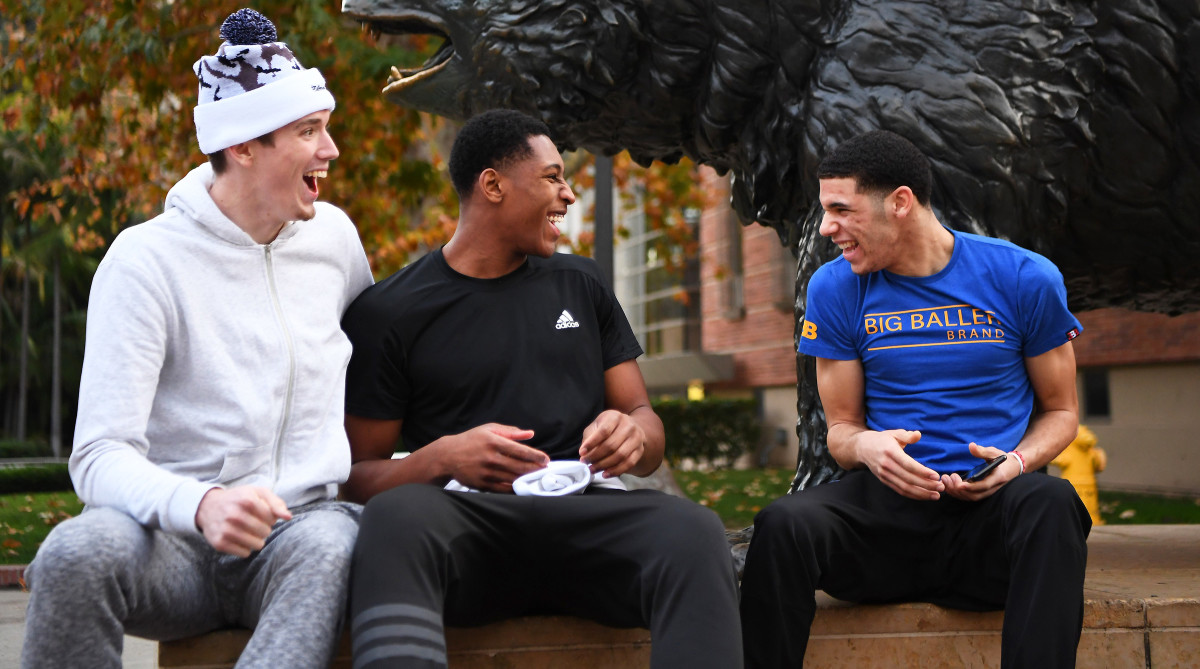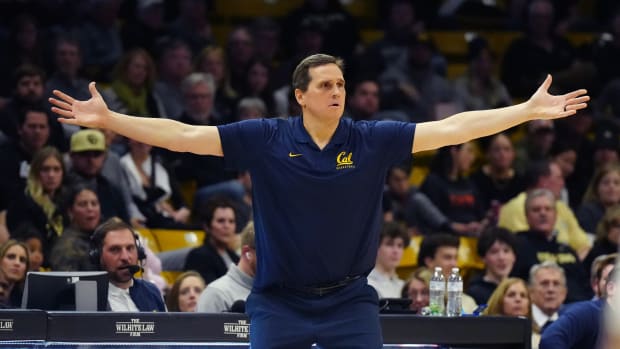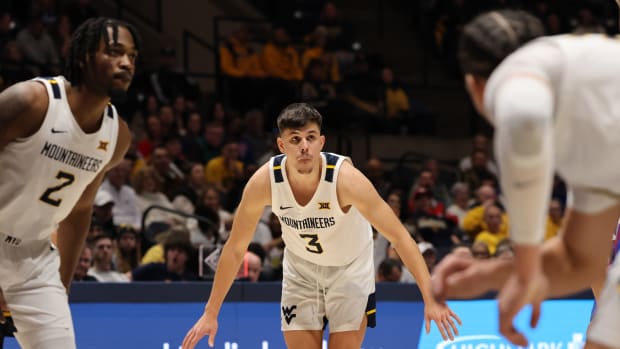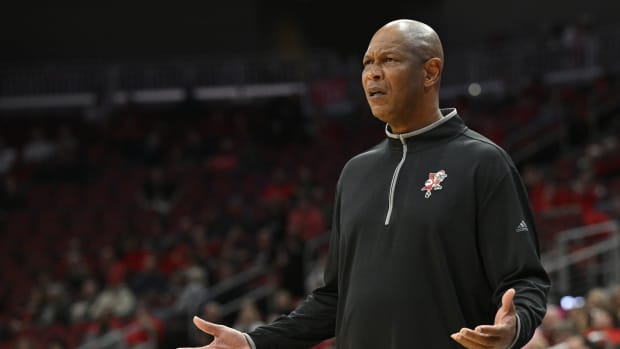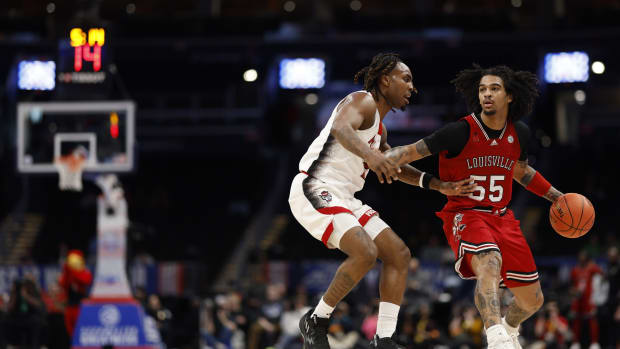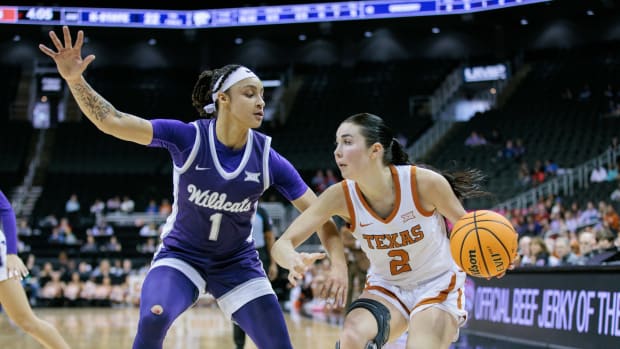Fun & Gun: A week behind the scenes with UCLA, the best show in college basketball
This story originally appeared in the Jan. 23, 2017, issue of Sports Illustrated. Subscribe to the magazine here.
The short ones, the pudgy ones, the ones who couldn’t drive or kick, pick or roll, rise or finish, those were the players Lonzo Ball wanted. You could take the five-star recruits with the superhuman wingspans and astronomic verticals, with the vision and knowledge and feel. But not the scrawny 16-year-old perched at the end of the bench, still waiting for that growth spurt, still working on that left hand. You had to leave him for Lonzo.
The ritual unfolded after practice at Chino Hills High, Ball begging the JV to stick around for pickup games, then assembling the most ragamuffin squad he could. It extended to the half-court in his backyard, Ball plucking some uncoordinated neighborhood kid, then challenging all comers to two on two. “You learn that everyone has a skill,” Ball says. “You just have to find it and bring it out.”
He often gravitated toward the same doughy 5' 2" guard with a sweet corner three and not much else, because the boy’s limitations forced Ball to manipulate defenders before feeding his little sidekick in the corner. While his peers joined the usual superstar conglomerates, desperate to partner with the best, Ball sought out the worst. “Everybody wins with good players,” his father, LaVar, told him. “But if you win with these guys, you’ll win with anybody.”
Ball never fled to Southern California’s AAU powers or private schools. When top prospects asked to run with him, he usually demurred. He could dish to his dynamic younger brothers, LiAngelo and LaMelo, at the local high school and with the Big Ballers AAU program his dad established. But LaVar made sure the rosters weren’t stacked, for fear his point guard prodigy might ever be tempted to yield responsibility. Lonzo’s staggering success last season at Chino Hills—where he averaged a triple double for a high school phenomenon that went 35–0, scored 98 points per game, beat every opponent by double figures and sold out gyms in less than 10 minutes—posed a question that LaVar has pondered for some time: What if Zo ever did hook up with McDonald’s All-Americans, deadeye snipers and go-go drivers, a power forward who resembles a lottery pick and a center who fetches lobs at the square? What if he was flanked by hardened vets and springy teens who hail from basketball families as renowned as his, with a coach who feels his burdens and a fan base that shares his expectations? What in the Big Baller World would that look like?
It is a blur, the 6' 6" Ball careening down the court, eyes fixed on a destination others can’t see. With one wrist flick he initiates a mesmerizing game of hot potato, inevitably culminating with another uncontested moonbeam. Here marks a return to college hoops the way Nolan Richardson and Jerry Tarkanian intended, before robotic point guards stood motionless atop the key staring at the sideline for further instructions, before Connecticut won a national championship game with 53 points.
SI spent last week with No. 3 UCLA and its new souped-up scoring machine, a high-octane apparatus that regularly cracks triple digits, applauds 30-foot shots and encourages four-second possessions while rejecting stilted sets and ball screens. Film sessions are spliced with Warriors highlights, staff meetings include Sasquatch sightings, and a hard drive named Dirk may need more room. “Put on your seat belt,” coach Steve Alford instructs his assistants.
The Bruins move fast.
Behind the scenes with UCLA men's basketball
T.J. Leaf, Ike Anigbogu and Lonzo Ball
T.J. Leaf, Lonzo Ball and Ike Anigbogu
Ike Anigbogu
Lonzo Ball and T.J. Leaf
T.J. Leaf
T.J. Leaf and Bryce Alford
Lonzo Ball and Ike Anigbogu
Bryce Alford
Lonzo Ball
Steve Alford
The two Turkish students who live on the fifth floor of Rieber Vista, in a pod with five singles, express no interest in the three oversized freshmen who share their personal space. Either the Turks don’t know, or don’t care, that Ball dishes out 8.0 assists (second most in the nation), that 6' 10" power forward T.J. Leaf is UCLA’s second-leading scorer (16.8), that 6' 10" center Ike Anigbogu blocks shots and flushes lobs like DeAndre Jordan in training. What these young giants can’t do is hook up basic cable, which is fine when they’re playing PS4, but a crisis when college football’s national championship game comes on TV.
Ball, Leaf and Anigbogu retreat to the plush players’ lounge at Pauley Pavilion, where they access a functioning big screen as well as a Ping-Pong table. Ball slams an overhead past Leaf, nearly shattering the framed photo on the back wall depicting UCLA’s 11 championship trophies. Leaf dives for cover. Alabama scores an early touchdown. “Run ‘em out of the gym!” Ball hollers. “I mean, the field.”
The freshmen are inseparable. They live together. They eat together. They shop at the Beverly Center together. “Not the seventh floor,” Ball clarifies. “That’s Prada and Gucci and all the stuff we can’t afford.” In case they miss each other at night, Leaf decorated his single with a picture left by a fan at Oregon State. “It’s a drawing,” Leaf explains, “of Lonzo’s head in the sky.” The trio even took the same classes, marveling at the one professor who correctly pronounced Anigbogu’s name (EE-kay ah-nee-BOH-goo), until a controversial split this quarter. “Those two are doing African-American studies,” Anigbogu says. “I’m in econ.” Ball shoots him a glare. “Ike gets sick of us,” he says.
Expert predictions: SI writers make midseason picks for Final Four & more
Sitting on high-backed leather chairs, as Clemson shows signs of a comeback, the baby Bruins reveal the plots of the scripts they authored for screenwriting class. Leaf’s is a drama set in Austria about a love triangle in which one member is a German spy. Anigbogu’s, inspired by Alfred Hitchcock’s Psycho, is a thriller set in a mountain resort where two American students are mysteriously killed. “Mine is about high school,” Ball says, “a guy and a girl.” He coughs up no details. “Yeah, your girl,” Leaf says. Ball gazes blankly at the TV.
The freshmen are all from Southern California—Leaf grew up near San Diego; Anigbogu in Corona, 48 miles southeast of L.A.—and they are preparing for a Pac-12 trip to Colorado and Utah. Leaf wears a Nets ski hat with gym shorts. “I’ve seen snow once,” Ball says, “last year in Massachusetts.”
“It snowed in Corona,” Anigbogu claims, between bites of Lamonica’s pepperoni. “The only way there was snow in Corona,” Ball protests, “is if you went up the mountain, got the snow and brought it back down.” Anigbogu scrolls fruitlessly through his Instagram account for evidence.
The Bruins are 16–1. They lead the nation in offensive efficiency. They boast the highest effective field goal percentage since the stat was popularized 15 years ago. The freshmen are asked if they can imagine, three months from now, playing in a national championship game of their own. They look back at the TV. “Not yet,” Ball says.
UCLA is coming off a modest 14-point home win over Stanford, and as Alford strode through the locker room afterward, he was struck by a sound he didn’t like: silence. “The last thing I want is for our guys to think, Oh, man, we only won by 14,” Alford tells his staff Tuesday morning in a conference room on the second floor of the J.D. Morgan Center. “We can’t let them lose the joy of this. They’ve created a buzz here. I want them to enjoy that creation.”
Alford, an Indiana heirloom who played for Bob Knight, does not need to summon the General right now. He has to lighten the mood. After strength and conditioning coach Wes Long references his hometown of Houston, Alford cracks, “Katy, not Houston.” After assistant coach Duane (Seatbelt) Broussard rises from his chair to take a phone call—a habit that spawned his nickname—Alford peppers him with questions about the existence of Big Foot. Broussard takes the bait, claiming that 200 of the beasts are still living, mostly in the Pacific Northwest, more female than male. “We don’t get many down here because of the fur,” Broussard says. “I’ve read articles.”
“Yeah,” Alford deadpans. “In National Enquirer.”
He is just getting warmed up. To start an afternoon film session with the team at Pauley, he queries freshman walk-on Isaac Wulff about his love life. “We’re 16–1,” Alford says. “Are you getting stopped?”
“Not stopped,” Wulff admits. “Maybe looked at.”
“So it’s like our pick-and-roll defense,” Alford concludes. “A work in progress.”
He turns his attention to center Thomas Welsh, who was watching a movie during Clemson-Bama. “Was it Hoosiers?” Alford asks. “I hope it was Hoosiers.”
The football game gives him a perfect segue. “You know how Clemson won?” he asks the group. “The pace of the game wore Alabama down. When teams play us, what do they have to be concerned about? Pace! Can they play at our pace for 40 minutes? The answer is no.”
Bracket Watch: No. 1 seeds hold spots, but Gonzaga, Kentucky are close behind
UCLA went 15–17 last season, finishing 73rd in adjusted tempo, and at the end Alford trashed the entire offense. “We ran the same pick-and-rolls as everybody else,” he says, “and I got so bored watching it.” He wanted to install a turbocharged motion attack, modeled after the Warriors and the Spurs, and conveniently he was getting a point guard uniquely qualified to direct it. Ball has been throwing alley-oops since he was six, sprinting up the hills near his home, joining YMCA games against adults. His father told him to play as fast as possible because more possessions meant more reps, and the only way to beat grown men was to outrun them. The Big Baller movement was born.
Alford relates to Ball in a way that few coaches can, mainly because few college players are legitimately famous, particularly in the one-and-done era. When UCLA traveled to Australia this summer, Alford saw fans mob Ball after games and recognized he was looking at a modern version of himself. After the trip Alford drove to Ball’s house in Chino Hills. “I’m not talking to you as a coach,” he started. “I’m talking to you as Mr. Basketball in Indiana who went to the state school. Everything that’s happening to you is about to heighten. It’s going to be two, three, four times what it is today. Don’t believe in pats on the back or kicks in the tail. Do what you do.”
In the film room images of Ball and the Bruins rush across the projector: a post-up early in the shot clock (“That only took eight seconds!” Alford announces), a go-ahead pass for three (“two seconds!”) and finally a lefthanded jump hook by Anigbogu, while missing an Adidas. “We looked at the analytics,” Alford crows. “Ike was the only guy in the country this weekend who made a lefty jump hook with one shoe.”
The numbers reveal much more than that. Kory Barnett, UCLA’s director of player development, and Kory Alford, the video coordinator, keep all the data on an orange Lacie hard drive they nicknamed Dirk. They should probably call it Steph. They run by far the fewest pick-and-rolls in the Pac-12, 9.5 per game, but they are doing it the most efficiently. “Just like the Warriors,” Kory Alford says, calling up NBA stats on Synergy. Golden State finished 30th in pick-and-roll attempts last season but averaged the most points in those possessions.
The Bruins channel the Dubs in many ways. Their leading scorer last season was 6' 5" guard Isaac Hamilton, but with the influx of prized freshmen, Hamilton is spending his senior year cutting off the ball and shooting from the corner. Naturally, coaches send him clips of Klay Thompson. “On my court at home, the farthest shot was from the corner, just because of the way the backyard was laid out,” says Hamilton, who grew up in South L.A. “So when you played H-O-R-S-E, you went to the corner. I like that spot.”
Hamilton sits under arched ceilings on the third floor of Royce Hall, waiting for his first European history class of the quarter. He watched a documentary the night before called Minimalism and is pondering ways to tidy up his life. That may be difficult. Hamilton shares a spotless garden apartment west of campus with teammates Welsh and Prince Ali that is decorated with a California flag, a poster of Michael Jordan at the 1987 dunk contest and little else. “Yeah, but there’s stuff in my refrigerator I don’t really need,” Hamilton says. He does keep a mini fridge in his bedroom. He leaves the big one for Welsh, a seven-footer who struggles to add weight, and he organizes it when the big man isn’t looking. He also remakes beds and refolds towels in hotels, a habit that confounds his road roommates.
Bubble Watch: Big Ten should be the most interesting conference in the country
The professor begins. “The final exam will be March 23. If you can’t make it because you are going away on a ski vacation—or I don’t know what—that will be a big problem.” Hamilton jots the date in his notebook. March 23 is the first day of the Sweet 16.
Hamilton was Alford’s second recruit, trailing only the coach’s youngest son, Bryce. When Alford coached at Iowa, Bryce was in elementary school, and he watched so much video with his dad that he memorized the names and numbers of every player in the Big Ten. “Devin Harris was at Wisconsin, and I always said, ‘He’s been there forever!’“ Bryce recalls. “Now that’s what everybody says about me.”
The 6' 3" senior marksman has scored 1,702 points at UCLA and endured almost as many tired Daddy’s Boy chants. He begs for some originality. “I think I’ve been through everything as a college player,” Bryce says. “Winning, losing, ups, downs, so much pressure. Handle the ball, run off screens, get open looks, worry about other guys. There were times I couldn’t focus on one thing. My mind was all over the place. And no matter what I did, people still thought I only played because my dad was the coach.” It is Wednesday night, and the Bruins are riding on the Northwest Parkway from Denver International Airport to the Renaissance in Boulder. Bryce’s hushed voice is the only sound on the bus.
“This is the most comfortable I’ve been here,” he continues, “because the pressure isn’t on me as much. I’ve learned to deal with it, but Lonzo has helped a lot too. You look at how much attention is on him, how much hype he’s getting, how much he handles the ball. Not many guys could have taken that burden off me, but he did.” When UCLA suffered its lone loss at Oregon in December, after Bryce missed the front end of a one-and-one in the final seconds, he checked his Twitter feed. He saw the light next to the notifications. He can’t bear to leave that light on. “There were about 200 tweets,” he estimates. “I read the first two and put it away.”
Late Thursday night, after pasta and ice cream at the Renaissance, he reads them all. Bryce has just scored a career-high 37 points at Colorado—”Get 40!” Lonzo shouted in the closing minutes—and UCLA has tied a school-record with 19 three-pointers en route to a 104–89 win. Bryce and Hamilton combined for 13 of the treys, a reminder that the Bruins’ seniors are almost as crucial as the freshmen, because defenders can’t help off either one without risking an aerial assault.
Bryce and Hamilton have sacrificed, though not as much as sophomore spark plug Aaron Holiday, perhaps the best player in the country who isn’t starting. Lying on his double bed in room 524 at the Salt Lake City Center Marriott on Friday afternoon, watching a replay of the UCLA gymnastics meet against Arkansas, Holiday checks to see if his older brothers are playing. Jrue, the starting point guard for the Pelicans, and Justin, a backup shooting guard for the Knicks, both have nights off.
The Holidays are hoops royalty in Los Angeles, but so are the Hamiltons. Isaac has an older brother, Jordan, who played in the NBA, and a younger one, Daniel, who is in the D-League. Leaf, like Ball, was coached by his father. Even coach Alford still calls his dad, Sam, to talk about strategy before and after every game. When Alford moved the 6' 1" Holiday to a sixth man role, after starting at the point last season, the coaching staff braced for some blowback. But Holiday was buoyed by his brothers, who suggested that experience off the bench would help him as a pro. He was also counseled by another jitterbug guard, who has seen up close the damage that dual ballhandlers can wreak.
“That’s what I did with Cameron Dollar,” says Tyus Edney. “One of us would get the ball, and the other would run as fast as we could. It can speed you up even more.” After winning UCLA’s last national championship in 1995, Edney spent 15 years in the NBA and overseas, then returned to his alma mater in 2010 as director of basketball operations. Doug Erickson, the team’s long-tenured administrative director, presented Edney with DVDs of all his games. “I just recently started watching our ‘95 team,” Edney says. “The fast breaks, the dunks, the way we pushed the ball, you look at what we did and what these guys are doing and you think, Maybe this is how UCLA is supposed to play.”
He is watching the Bruins perform a rollicking five-on-five drill, implemented by assistant coach Ed Schilling, called Quick Strike. The sides scrimmage with a 15-second shot clock, but when they make a basket, the number of points they receive corresponds to the number of seconds on the shot clock. So if they score with 11 seconds left, they are awarded 11 points. Every possession is a race.
Edney is 43, but he checks in at 167 pounds—two over his playing weight. In his presence, it is still a spring day in Boise, and the clock reads 4.8. Ball was not alive for Edney’s full-court dash in the second round of the 1995 NCAA tournament against Missouri, but early this season he put 4.8 seconds on the clock at Pauley and took off. He made one cut, same as Edney, and beat the buzzer, same as Edney. He sprinted triumphantly to the locker room.
Edney and Ball have different styles, but when Edney pops in those old DVDs, he spots the original Lonzo: another California-bred floor general who was big but fast, daring but controlled, placid but willful. He too identified more as a passer than a scorer, and in his company, even selfish players felt compelled to share. “It’s scary,” Edney says, “how much Lonzo is like Jason Kidd.”
The amateur figure skaters, wiping out on the rink below the second-floor window, provide comic relief as the Bruins convene in a Marriott ballroom for film study Friday night. UCLA’s downfall is defense, specifically against the pick-and-roll, and maneuvering around screens is a constant source of concern. “We’ve got to get pissy when these teams screen us,” Alford says. “Bigs, you’ve got to prepare for a fight. Guards, you’ve got to take the screens personal.” The Bruins review which Utah shooters they have to chase over screens (“the Currys,” Alford calls them) and which they can sag under (“the Rondos.”) They spend about 90% of the meeting on pick-and-roll defense, but still the Utes shred them with 50 points in the paint Saturday afternoon. Throughout the second half, UCLA coaches discuss the right time to rest Ball, who has little experience at altitude. But the game is tight. They can’t afford to sit him.
“Doesn’t matter,” says Darren Moore, Ball’s trainer, seated behind the UCLA bench. “His dad never took him out, either. Lonzo was built for days like this.” Early in the season LaVar lit into his eldest son, accusing him of growing deferential. “Don’t just get stuck on the passes,” LaVar said. “I want the dunks, the threes, the flying. I want you to entertain—and beat the hell out of ‘em.”
Lonzo satisfies all of LaVar’s requests at Utah, scoring 17 points with eight assists and five steals in 40 minutes. But the box score does not do him justice. While the Utes keep halting the tempo, Zo keeps revving it back up, driving and kicking before Utah can set its D. He finds Bryce and Holiday for the game’s critical buckets, both threes, and with 12 seconds left Utah calls timeout trailing by a point. “We need another big,” Ball tells Alford, and the coach summons Welsh to flank Leaf on the front line.
Leaf forces an off-balance three by Utah’s Kyle Kuzma—”Like a Chargers defensive back,” Alford tells the San Diego native—and Welsh cradles the rebound. The team that does nothing but score wins with a stop, 83–82, improving to 18–1 and sweeping a Pac-12 road trip for the first time in Alford’s four years at UCLA. “Once you build a monster, you have to feed him,” LaVar says. “Lonzo eats those W’s.”
LaVar is as outspoken as Lonzo is reserved, making clear his son will be in the NBA pretty soon, no surprise given how many general managers project him as a top three draft pick. Although Lonzo’s shooting motion is unorthodox—he raises the ball from his left hip to his right side—it’s plenty effective. Without their precocious ringleader, the Bruins may slow a step, but Alford hopes not. UCLA has inked the No. 2–rated recruiting class, including sharpshooter LiAngelo Ball, and coaches believe their breakneck style will appeal to more So Cal families who favor Showtime.
College hoops is forever consumed by the future, but in this instance, it’s worth curbing the pace and admiring the view: a basketball blue blood returned to prominence, led by freshmen and seniors, a legend on the sideline and a phenom at the point.
Bryce leaps across the narrow hallway that separates the showers from the locker room at the Huntsman Center, wearing nothing but a towel as the Utah cheerleaders file past. Ball spots Leaf, conducting a postgame interview, and dances to distract him. They stroll together out of the silenced arena, toward the snow, a couple of newly minted winter warriors. “Lonzo is a child,” Leaf jabs. “But he has his moments.”
This is one.
